Selective serotonin reuptake inhibitors (SSRIs) inhibit insulin secretion and action in pancreatic β cells
- PMID: 23275337
- PMCID: PMC3581374
- DOI: 10.1074/jbc.M112.408641
Selective serotonin reuptake inhibitors (SSRIs) inhibit insulin secretion and action in pancreatic β cells
Erratum in
-
Selective serotonin reuptake inhibitors (SSRIs) inhibit insulin secretion and action in pancreatic β cells.J Biol Chem. 2018 Mar 23;293(12):4577-4578. doi: 10.1074/jbc.AAC118.002476. J Biol Chem. 2018. PMID: 29572328 Free PMC article. No abstract available.
Abstract
Selective serotonin reuptake inhibitors (SSRIs) are antidepressants used for the treatment of mood and anxiety disorders. Here, we demonstrate that incubation (2 h) of murine islets or Min6 β cell line with the SSRIs paroxetine, fluoxetine, or sertraline inhibited insulin-induced Tyr phosphorylation of insulin receptor substrate (IRS)-2 protein and the activation of its downstream targets Akt and the ribosomal protein S6 kinase-1 (S6K1). Inhibition was dose-dependent with half-maximal effects at ∼15-20 μM. It correlated with a rapid dephosphorylation and activation of the IRS kinase GSK3β. Introduction of GSK3β siRNAs eliminated the inhibitory effects of the SSRIs. Inhibition of IRS-2 action by 30 μM SSRI was associated with a marked inhibition of glucose-stimulated insulin secretion from murine and human pancreatic islets. Secretion induced by basic secretagogues (KCl and Arg) was not affected by these drugs. Prolonged treatment (16 h) of Min6 cells with sertraline resulted in the induction of inducible nitric oxide synthase; activation of endoplasmic reticulum stress, and the initiation of the unfolded protein response, manifested by enhanced transcription of ATF4 and C/EBP homologous protein. This triggered an apoptotic process, manifested by enhanced caspase 3/7 activity, which resulted in β cell death. These findings implicate SSRIs as inhibitors of IRS protein function and insulin action through the activation of GSK3β. They further suggest that SSRIs inhibit insulin secretion; induce the unfolded protein response; activate an apoptotic process, and trigger β cell death. Given that SSRIs promote insulin resistance while inhibiting insulin secretion, these drugs might accelerate the transition from an insulin-resistant state to overt diabetes.
Figures
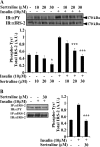
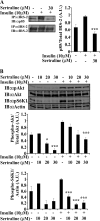


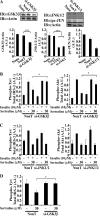

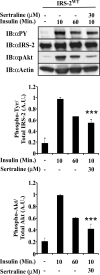


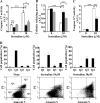
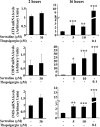
Similar articles
-
The selective serotonin reuptake inhibitors, sertraline and paroxetine, improve islet beta-cell mass and function in vitro.Diabetes Obes Metab. 2024 Sep;26(9):3606-3617. doi: 10.1111/dom.15701. Epub 2024 Jun 18. Diabetes Obes Metab. 2024. PMID: 38888050 Free PMC article.
-
Antidepressants induce cellular insulin resistance by activation of IRS-1 kinases.Mol Cell Neurosci. 2007 Nov;36(3):305-12. doi: 10.1016/j.mcn.2007.05.009. Epub 2007 Jun 29. Mol Cell Neurosci. 2007. PMID: 17728140
-
Hypobaric hypoxia exposure in rats differentially alters antidepressant efficacy of the selective serotonin reuptake inhibitors fluoxetine, paroxetine, escitalopram and sertraline.Pharmacol Biochem Behav. 2018 Jul;170:25-35. doi: 10.1016/j.pbb.2018.05.002. Epub 2018 May 5. Pharmacol Biochem Behav. 2018. PMID: 29738811
-
Pharmacokinetic-pharmacodynamic relationship of the selective serotonin reuptake inhibitors.Clin Pharmacokinet. 1996 Dec;31(6):444-69. doi: 10.2165/00003088-199631060-00004. Clin Pharmacokinet. 1996. PMID: 8968657 Review.
-
Clinical effects of pharmacological variations in selective serotonin reuptake inhibitors: an overview.Int J Clin Pract. 2005 Dec;59(12):1428-34. doi: 10.1111/j.1368-5031.2005.00681.x. Int J Clin Pract. 2005. PMID: 16351675 Review.
Cited by
-
First quantitative high-throughput screen in zebrafish identifies novel pathways for increasing pancreatic β-cell mass.Elife. 2015 Jul 28;4:e08261. doi: 10.7554/eLife.08261. Elife. 2015. PMID: 26218223 Free PMC article.
-
Silymarin attenuates escitalopram (cipralex) induced pancreatic injury in adult male albino rats: a biochemical, histological, and immunohistochemical approach.Anat Cell Biol. 2023 Mar 31;56(1):122-136. doi: 10.5115/acb.22.204. Epub 2023 Jan 10. Anat Cell Biol. 2023. PMID: 36624692 Free PMC article.
-
The Relevance of Glutathione Reductase Inhibition by Fluoxetine to Human Health and Disease: Insights Derived from a Combined Kinetic and Docking Study.Protein J. 2019 Oct;38(5):515-524. doi: 10.1007/s10930-019-09834-7. Protein J. 2019. PMID: 31004256
-
Common Medications Which Lead to Unintended Alterations in Weight Gain or Organ Lipotoxicity.Curr Gastroenterol Rep. 2016 Jan;18(1):2. doi: 10.1007/s11894-015-0479-4. Curr Gastroenterol Rep. 2016. PMID: 26700070 Review.
-
Management of Pregnant Women with Mental Disorders Requires Attention to Gestational Diabetes Mellitus.Womens Health Rep (New Rochelle). 2024 Feb 23;5(1):170-177. doi: 10.1089/whr.2023.0112. eCollection 2024. Womens Health Rep (New Rochelle). 2024. PMID: 38414885 Free PMC article.
References
-
- Gram L. (1994) Fluoxetine. N. Engl. J. Med. 331, 1354–1361 - PubMed
-
- Holsboer F., Barden N. (1996) Antidepressants and hypothalamic-pituitary-adrenocortical regulation. Endocr. Rev. 17, 187–205 - PubMed
-
- Raeder M. B., Bjelland I., Emil Vollset S., Steen V. M. (2006) Obesity, dyslipidemia, and diabetes with selective serotonin reuptake inhibitors: the Hordaland Health Study. J. Clin. Psychiatry 67, 1974–1982 - PubMed
-
- Brown L. C., Majumdar S. R., Johnson J. A. (2008) Type of antidepressant therapy and risk of type 2 diabetes in people with depression. Diabetes Res. Clin. Pract. 79, 61–67 - PubMed
-
- Andersohn F., Schade R., Suissa S., Garbe E. (2009) Long-term use of antidepressants for depressive disorders and the risk of diabetes mellitus. Am. J. Psychiatry 166, 591–598 - PubMed
Publication types
MeSH terms
Substances
LinkOut - more resources
Full Text Sources
Other Literature Sources
Research Materials

